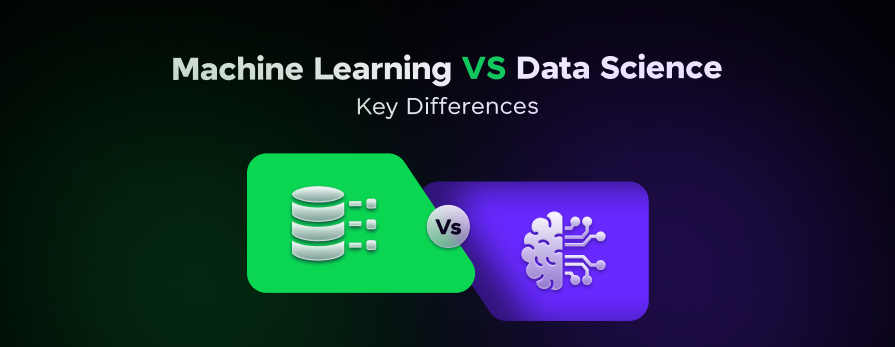
Machine Learning vs. Data Science: Key Differences
Oct 22, 2024 8 Min Read 1424 Views
(Last Updated)
Machine learning and data science are two of the most prominent and rapidly growing fields in technology today. While closely related and often overlapping, these disciplines have some important distinctions in their focus, methodologies, and applications. This blog post will explore the key differences between machine learning vs. data science to provide clarity on these frequently conflated terms.
We’ll examine how these fields are defined, their core components and techniques, the skills required, typical job roles and career paths, and how they are applied in the real world. By the end, you should have a clearer understanding of how machine learning fits within the broader scope of data science, and how to distinguish between these two exciting and impactful domains.
Table of contents
- Definitions and Scope
- Data Science
- Machine Learning
- Core Components and Techniques
- Data Science
- Machine Learning
- Required Skills and Knowledge
- Data Science Skills
- Machine Learning Skills
- Typical Job Roles and Career Paths
- Data Science Roles
- Machine Learning Roles
- The Data Science Process vs. The Machine Learning Workflow
- Data Science Process
- Machine Learning Workflow
- Tools and Technologies
- Common Data Science Tools
- Common Machine Learning Tools
- Real-World Applications
- Data Science Applications
- Machine Learning Applications
- Future Trends & Career Opportunities
- Data Science Future Trends
- Machine Learning Future Trends
- Conclusion
- FAQs
- What is the main difference between machine learning and data science?
- Can a data scientist be a machine learning expert?
- Which is more important: machine learning or data science?
- How do salaries for data science and machine learning roles compare in India?
1. Definitions and Scope
Let’s start by defining each field:
Data Science
Data science is a multidisciplinary field that uses scientific methods, processes, algorithms, and systems to extract knowledge and insights from structured and unstructured data. It encompasses a wide range of activities involved in collecting, processing, analyzing, and interpreting data to solve complex problems and inform decision-making.
Machine Learning
Machine learning is a subset of artificial intelligence focused on building systems that can learn from and make decisions or predictions based on data. It involves developing algorithms and statistical models that enable computer systems to improve their performance on a specific task through experience.
From these definitions, we can see that data science has a broader scope, with machine learning being one of its key components or toolsets. Data science is concerned with the full lifecycle of data – from acquisition to actionable insights. Machine learning, while a powerful set of techniques, is more narrowly focused on creating predictive models and algorithms that can learn from data.
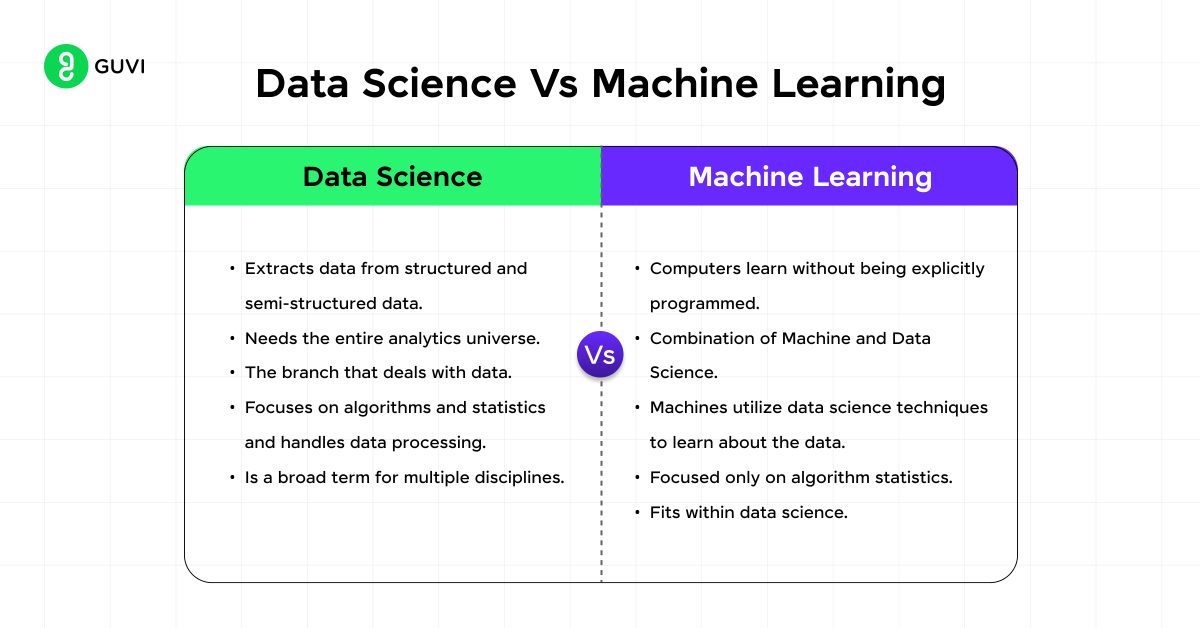
2. Core Components and Techniques
To further illustrate the differences, let’s break down some of the core components and techniques used in each field:
Data Science
- Data Collection and Storage: This involves gathering raw data from various sources and ensuring it is stored securely for analysis. The quality of data collection directly impacts the insights derived.
- Data Cleaning and Preprocessing: Before analysis, data needs to be cleaned and processed to handle missing values, remove duplicates, and transform it into a usable format. This step is crucial for accurate results.
- Exploratory Data Analysis (EDA): EDA helps in understanding the underlying patterns and relationships within the data. It’s an initial investigation that guides further analysis and modeling.
- Statistical Analysis and Hypothesis Testing: These techniques are used to draw meaningful inferences from data, validate assumptions, and determine the statistical significance of results.
- Data Visualization: Presenting data visually using charts, graphs, and plots to communicate findings effectively. Good visualization helps in better decision-making by making complex data more understandable.
Machine Learning
- Supervised Learning Algorithms: These algorithms learn from labeled data to make predictions or classify data points. Common examples include linear regression and decision trees.
- Unsupervised Learning Algorithms: Used when data isn’t labeled, these algorithms identify hidden patterns or groupings in the data. Clustering and dimensionality reduction are key techniques.
- Reinforcement Learning: This involves training models to make sequences of decisions by rewarding desirable actions. It’s commonly used in robotics and gaming.
- Neural Networks and Deep Learning: These are advanced algorithms that mimic the human brain’s neural structure to identify patterns in complex data. They are the foundation of AI applications like image and speech recognition.
- Model Evaluation and Selection: After building models, they must be evaluated using techniques like cross-validation to ensure accuracy. The best-performing model is then selected for deployment.
Enroll in GUVI’s Artificial Intelligence & Machine Learning course today and start mastering the skills that are shaping the future of AI.
These components highlight that while machine learning is a subset of data science, data science itself encompasses a broader range of techniques that span data processing, analysis, and visualization.
3. Required Skills and Knowledge
The different focus areas of data science and machine learning are reflected in the skills and knowledge required for each field:
Data Science Skills
- Programming (Python, R, SQL): Data scientists must be proficient in these programming languages to analyze data, build models, and interact with databases.
- Statistics and Probability: Understanding statistical methods is essential for analyzing data, identifying trends, and making predictions based on probabilities.
- Data Wrangling and Preprocessing: Cleaning and transforming raw data into a usable format is key to ensuring accurate analyses and model performance.
- Data Visualization: Using tools like Matplotlib, Seaborn, or Tableau to create visual representations of data helps communicate insights effectively to stakeholders.
- Machine Learning: While not as deep as in machine learning specialists, data scientists need to understand the basics of machine learning algorithms to build predictive models.
- Business Acumen and Communication: Data scientists must understand business problems and effectively communicate their findings to non-technical audiences, ensuring data-driven decisions are actionable.
Machine Learning Skills
- Programming (Python, R, sometimes C++, or Java): Machine learning specialists need strong coding skills to implement algorithms, build models, and optimize solutions.
- Linear Algebra and Calculus: These mathematical foundations are crucial for understanding how machine learning algorithms, especially neural networks, work.
- Machine Learning Algorithms and Frameworks: In-depth knowledge of algorithms (e.g., decision trees, SVM) and frameworks (e.g., TensorFlow, Scikit-learn) is required to build, train, and optimize models.
- Deep Learning and Neural Networks: Specialization in deep learning techniques helps in tackling complex tasks such as image recognition, NLP, and speech processing.
- Feature Engineering: Crafting meaningful features from raw data ensures models can make better predictions and perform well on new data.
- Model Evaluation and Optimization: Evaluating model performance using metrics like accuracy and precision, and optimizing them through hyperparameter tuning is essential for improving outcomes.
This breakdown highlights that while both fields share a common base, data science emphasizes business impact and communication, whereas machine learning demands deeper technical expertise in algorithms and optimization.
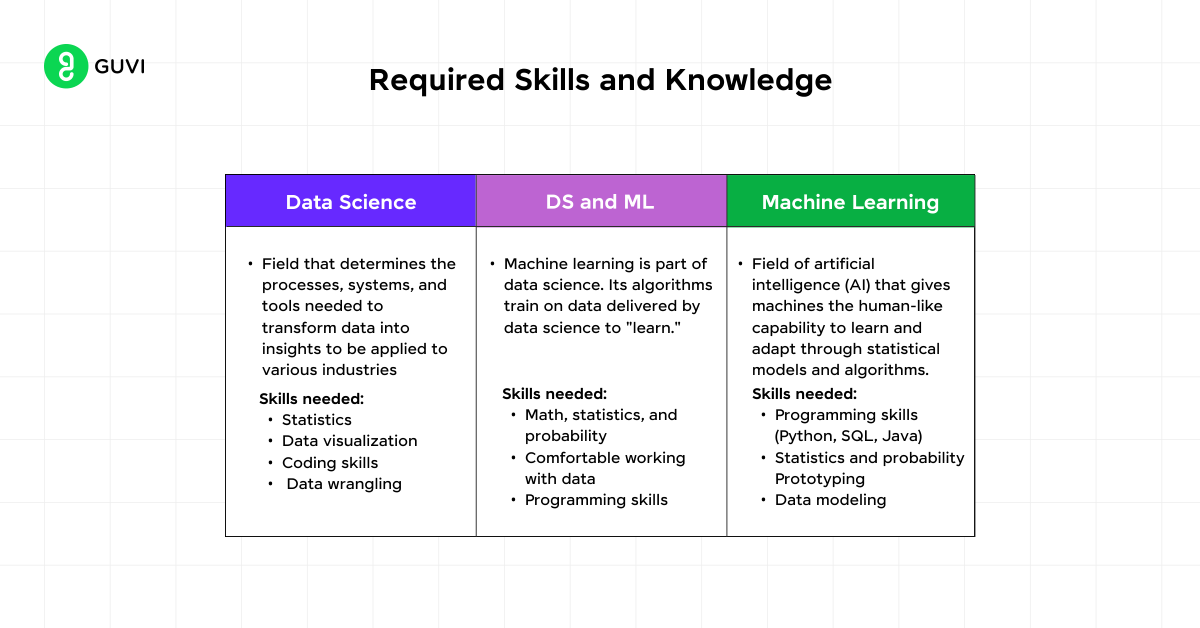
4. Typical Job Roles and Career Paths
The distinctions between data science and machine learning are also reflected in typical job roles and career paths:
Data Science Roles
- Data Scientist: Data scientists analyze large datasets to extract insights, build predictive models, and support decision-making. They work across various industries, from finance to healthcare.
Salary: ₹8-15 lakhs per annum, with experienced professionals earning up to ₹25 lakhs or more. - Data Analyst: Data analysts focus on interpreting data and creating reports to help organizations understand trends and make informed decisions. They often use tools like Excel, SQL, and Tableau.
Salary: ₹4-8 lakhs per annum. - Business Intelligence Analyst: BI analysts develop strategies based on data analysis to improve business performance. They create dashboards and reports to visualize data and support business decisions.
Salary: ₹6-10 lakhs per annum. - Data Engineer: Data engineers design, build, and maintain the infrastructure for data generation, ensuring data is accessible and usable for analysis. They work with big data technologies like Hadoop and Spark.
Salary: ₹8-16 lakhs per annum. - Analytics Manager: Analytics managers oversee data analysis projects, lead teams of data analysts and scientists, and ensure that data-driven strategies align with business goals.
Salary: ₹15-25 lakhs per annum. - Chief Data Officer: CDOs are senior executives responsible for the organization’s data strategy, ensuring that data is managed as a valuable business asset. They align data initiatives with company goals.
Salary: ₹30-50 lakhs per annum.
Machine Learning Roles
- Machine Learning Engineer: ML engineers design and implement machine learning models, often working on tasks like recommendation systems, predictive modeling, and automation.
Salary: ₹7-18 lakhs per annum. - AI Research Scientist: AI researchers focus on developing new algorithms and models to advance the field of artificial intelligence, often working in R&D departments or academia.
Salary: ₹15-35 lakhs per annum. - NLP Engineer: NLP engineers specialize in natural language processing, building models that understand and generate human language, used in applications like chatbots and translation services.
Salary: ₹8-20 lakhs per annum. - Computer Vision Engineer: These engineers work on algorithms that allow computers to interpret visual data, such as image recognition and video analysis, often used in areas like autonomous vehicles and healthcare imaging.
Salary: ₹10-22 lakhs per annum. - Robotics Engineer: Robotics engineers design and develop robots, integrating ML models to enable machines to perform tasks autonomously, often used in manufacturing, healthcare, and consumer products.
Salary: ₹6-15 lakhs per annum. - ML Ops Engineer: ML Ops engineers ensure that machine learning models are deployed, maintained, and monitored efficiently, bridging the gap between data science and IT operations.
Salary: ₹8-20 lakhs per annum.
These roles highlight the diversity in data science, with opportunities spanning various industries, while machine learning roles are more specialized, focusing on advanced technical tasks and cutting-edge technology development.
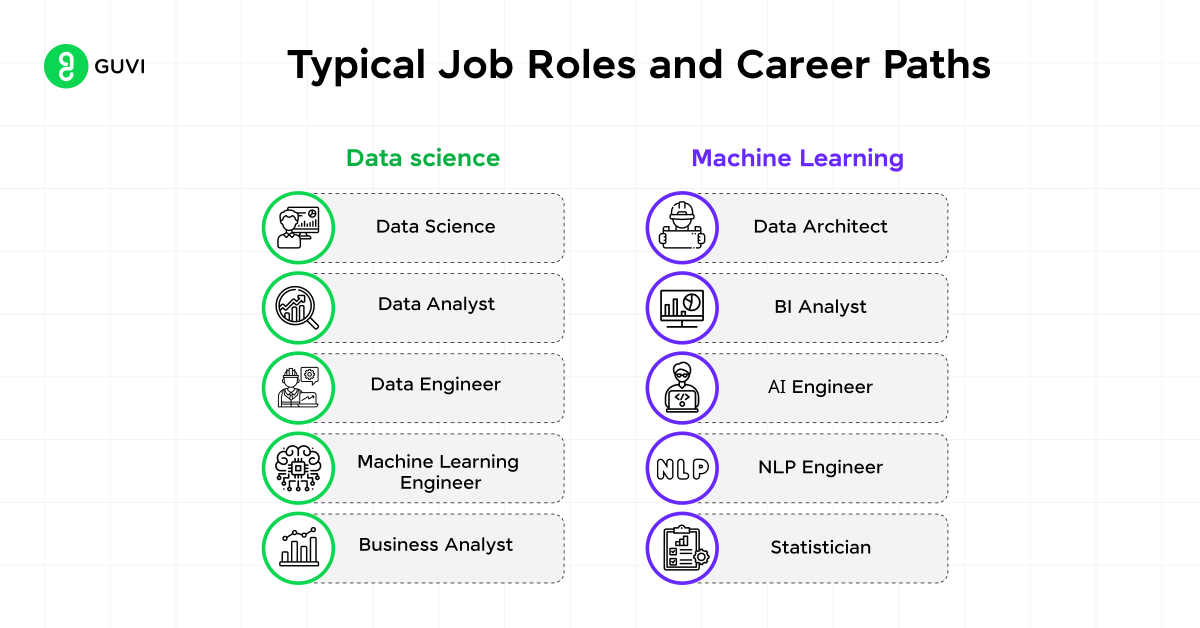
In terms of career progression in machine learning and data science, data scientists might start as data analysts, move into more senior data science roles, and eventually progress to leadership positions like analytics manager or chief data officer. Machine learning specialists might begin as ML engineers, advance to senior ML engineer or AI research scientist roles, and potentially move into specialized positions in areas like NLP or computer vision.
6. The Data Science Process vs. The Machine Learning Workflow
Another way to understand the differences between these fields is to compare their typical workflows:
Data Science Process
- Problem Definition: Understand the business problem and define clear objectives.
- Data Collection: Gather relevant data from various sources.
- Data Cleaning and Preprocessing: Handle missing values, outliers, and format issues.
- Exploratory Data Analysis: Understand data distributions, relationships, and patterns.
- Feature Engineering: Create new features or transform existing ones.
- Modeling: Apply statistical or machine learning techniques to build predictive models.
- Model Evaluation: Assess model performance and refine as needed.
- Interpretation and Visualization: Translate results into actionable insights.
- Communication: Present findings to stakeholders and make recommendations.
- Deployment and Monitoring: Implement solutions and track their performance over time.
Machine Learning Workflow
- Data Preparation: Clean and preprocess data for model training.
- Feature Engineering: Select or create relevant features for the model.
- Model Selection: Choose appropriate algorithms for the problem.
- Model Training: Use training data to teach the model.
- Model Evaluation: Assess performance on validation data.
- Hyperparameter Tuning: Optimize model parameters for best performance.
- Testing: Evaluate final model performance on unseen test data.
- Deployment: Integrate the model into production systems.
- Monitoring and Maintenance: Track model performance and retrain as needed.
The data science process is more comprehensive, covering the entire journey from problem definition to actionable insights and business impact. The machine learning workflow is more focused on the technical aspects of building and deploying predictive models.
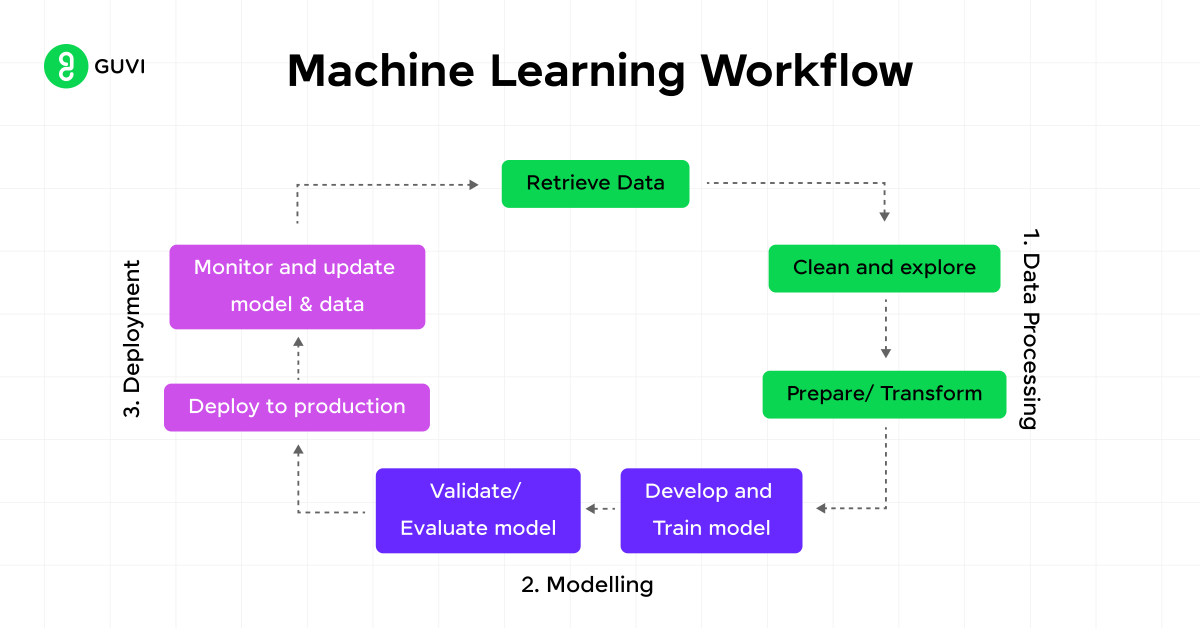
7. Tools and Technologies
While there is significant overlap in the tools used in data science and machine learning, there are some differences in emphasis:
Common Data Science Tools
- Python (pandas, numpy, scipy): Used for data manipulation, statistical analysis, and performing scientific computations with large datasets.
- R: A programming language specialized for statistical analysis and data visualization, popular in academia and research.
- SQL: Essential for querying, managing, and manipulating relational databases to extract and organize data.
- Tableau or PowerBI: Tools for creating interactive and visually appealing data dashboards and reports, enabling data-driven decision-making.
- Excel: A widely used spreadsheet tool for basic data analysis, visualization, and handling smaller datasets.
- Jupyter Notebooks: An interactive coding environment that allows combining code, visualizations, and narrative text for exploratory data analysis and reporting.
- Apache Spark: A big data processing engine used for large-scale data processing, enabling fast data manipulation and analysis.
- Hadoop: A framework for distributed storage and processing of big data, allowing efficient handling of large datasets across clusters.
- SAS: A software suite used for advanced analytics, statistical analysis, and data management, often in corporate environments.
- SPSS: A statistical software package used for analyzing complex survey data and conducting predictive analytics.
Common Machine Learning Tools
- Python (scikit-learn, TensorFlow, PyTorch): Libraries for building, training, and deploying machine learning models, from basic algorithms to deep neural networks.
- R (caret, mlr): Packages for implementing machine learning algorithms and streamlining the model-building process in R.
- Java (Weka, Apache Spark MLlib): Tools for building machine learning models and processing large datasets, often used in enterprise environments.
- MATLAB: A high-level language and environment for numerical computing, widely used in academia and industry for machine learning and signal processing.
- H2O: An open-source platform that provides scalable machine learning algorithms and supports both R and Python, used for building and deploying models.
- Amazon SageMaker: A cloud-based service for developing, training, and deploying machine learning models at scale, with integrated tools for end-to-end ML workflows.
- Google Cloud AI Platform: A suite of cloud services that offer tools for building, deploying, and managing machine learning models in the cloud.
- Microsoft Azure Machine Learning: A cloud-based platform that provides an integrated environment for developing, training, and deploying machine learning models.
- IBM Watson: An AI platform offering a suite of tools for machine learning, NLP, and data analysis, often used for enterprise-level AI solutions.
- NVIDIA CUDA: A parallel computing platform that enables the use of GPUs for accelerating machine learning model training, particularly in deep learning.
These tools and technologies cater to the unique needs of data science and machine learning professionals, providing specialized capabilities for different stages of data analysis, modeling, and deployment.

5. Real-World Applications
To further illustrate the differences between data science and machine learning, let’s explore some real-world applications of each:
Data Science Applications
- Customer Segmentation and Behavior Analysis: Analyzing customer data to segment them into different groups based on behavior, preferences, and demographics, allows businesses to target marketing efforts more effectively.
- Fraud Detection in Financial Services: Identifying suspicious activities in financial transactions by analyzing patterns and anomalies in data, helping prevent fraud and protect assets.
- Supply Chain Optimization: Using data to forecast demand, manage inventory, and optimize logistics, ensuring efficient and cost-effective operations in the supply chain.
- Healthcare Outcome Prediction: Analyzing patient data to predict health outcomes, optimize resource allocation, and improve patient care through data-driven decisions.
- Marketing Campaign Optimization: Evaluating the performance of marketing campaigns by analyzing data from multiple channels to optimize strategies, increase ROI, and reach target audiences effectively.
Machine Learning Applications
- Image and Speech Recognition: Training models to recognize and interpret visual and auditory data, enabling applications like facial recognition, voice assistants, and automated tagging in photos.
- Autonomous Vehicles: Developing algorithms that allow self-driving cars to perceive their environment, make decisions, and navigate roads safely without human intervention.
- Natural Language Processing (NLP): Enabling machines to understand, interpret, and generate human language, powering applications like chatbots, language translation, and sentiment analysis.
- Personalized Content Recommendations: Using algorithms to analyze user behavior and preferences to recommend personalized content, such as movies, music, or products on platforms like Netflix or Amazon.
- Medical Diagnosis and Drug Discovery: Leveraging ML to analyze medical data, identify potential diagnoses, and accelerate the discovery of new drugs by predicting how different compounds will behave.
These examples highlight that data science often focuses on broader business applications, while machine learning is more about creating intelligent systems capable of performing specific tasks autonomously.
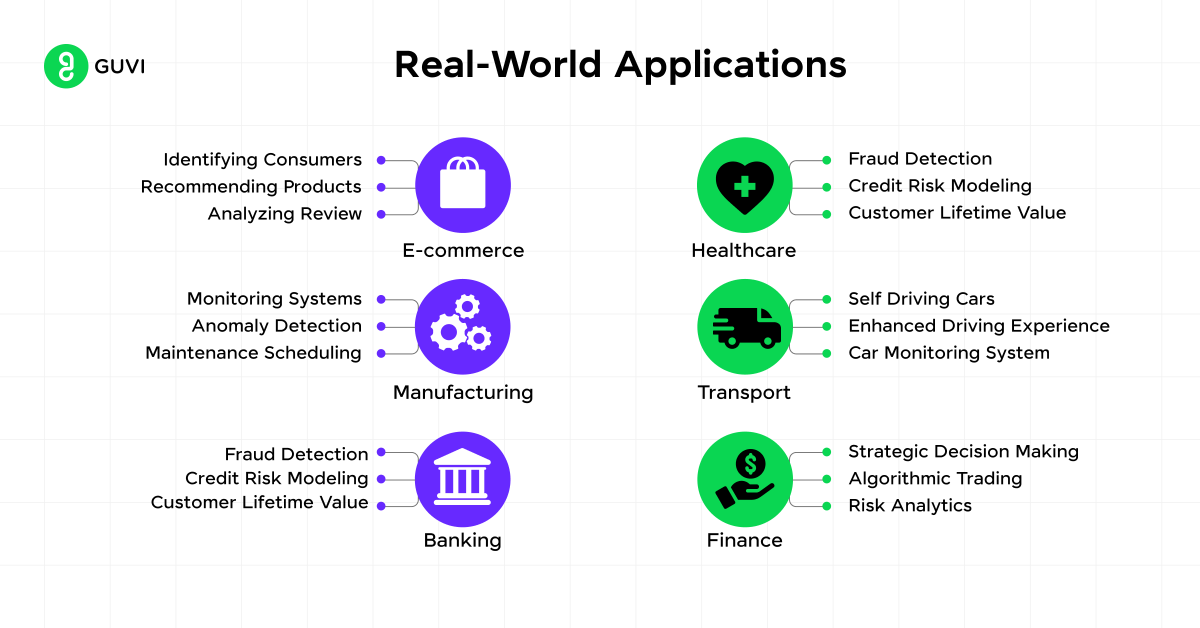
8. Future Trends & Career Opportunities
As we look to the future, both data science and machine learning continue to evolve rapidly:
Data Science Future Trends
The future of data science is poised to be shaped by a growing emphasis on real-time analytics, particularly as businesses seek to leverage streaming data for quicker decision-making. Automated machine learning (AutoML) tools are set to play a larger role, allowing even non-experts to build models, thus democratizing data science.
Additionally, the rise of edge computing and IoT analytics will enable faster processing and analysis of data directly at the source, reducing latency and improving responsiveness. With data governance and ethics becoming more critical, professionals in data science will be increasingly tasked with ensuring responsible data use.
Data Science Career Opportunities: As data becomes central to business strategy, the demand for data scientists, data analysts, and data engineers will continue to grow. Professionals with expertise in data governance, real-time analytics, and AutoML will be particularly sought after, with roles expanding into sectors that previously did not prioritize data-driven decision-making.
Machine Learning Future Trends
Machine learning is set to advance with breakthroughs in deep learning and neural network architectures, leading to more sophisticated AI models capable of handling complex tasks. The growth of reinforcement learning applications, particularly in autonomous systems and robotics, will further expand the capabilities of AI. As sustainability becomes a priority, there will be a push towards developing more energy-efficient AI systems, reducing the carbon footprint of training massive models.
Explainable AI (XAI) will gain traction, addressing the need for transparency and trust in AI decisions. Additionally, advancements in transfer learning and few-shot learning will enable models to learn from smaller datasets, making machine learning more accessible and adaptable. The integration of AI with robotics will open new frontiers in automation, particularly in industries like manufacturing, healthcare, and logistics.
Machine Learning Career Opportunities: The demand for machine learning engineers, AI research scientists, and specialists in fields like NLP and computer vision will continue to rise. As AI systems become more integrated into various industries, professionals skilled in reinforcement learning, XAI, and energy-efficient AI will find abundant career opportunities, particularly in tech-driven sectors and cutting-edge research fields.
While both fields are advancing quickly, we can see that data science trends tend to focus on broader applications and integration with business processes. Machine learning trends are often more technical, pushing the boundaries of what’s possible with AI systems.
Transform your career with GUVI’s Data Science course. Join now to gain the skills and insights you need to become a data-driven decision-maker.
Conclusion
In exploring the differences between data science and machine learning, we’ve covered key topics including core components, required skills, typical job roles, real-world applications, tools and technologies, and future trends. The primary distinction lies in their focus: data science takes a broader approach, integrating data analysis with business context and ethical considerations, while machine learning hones in on the development and optimization of algorithms for specific tasks.
Data science is about extracting insights and driving decisions across various domains, making it versatile and essential in many industries. On the other hand, machine learning is specialized, pushing the boundaries of AI to create systems that can learn and adapt autonomously. Understanding these differences can help you choose the path that aligns with your interests and career goals in the evolving landscape of technology.
FAQs
What is the main difference between machine learning and data science?
Machine learning focuses on creating models that learn from data, while data science encompasses the broader process of extracting insights from data, including using machine learning.
Can a data scientist be a machine learning expert?
Yes, a data scientist can specialize in machine learning, but their role often includes other tasks like data analysis, data cleaning, and business insights.
Which is more important: machine learning or data science?
Both are important; machine learning is a tool within data science. The importance depends on the project’s goals—whether it requires predictive modeling or broader data analysis.
How do salaries for data science and machine learning roles compare in India?
Machine learning roles generally offer higher salaries compared to data science roles due to the specialized technical skills required. For example, Machine Learning Engineers earn ₹7-18 lakhs per annum, while Data Scientists earn ₹8-15 lakhs per annum. The higher salaries in machine learning reflect the demand for advanced expertise in AI technologies.

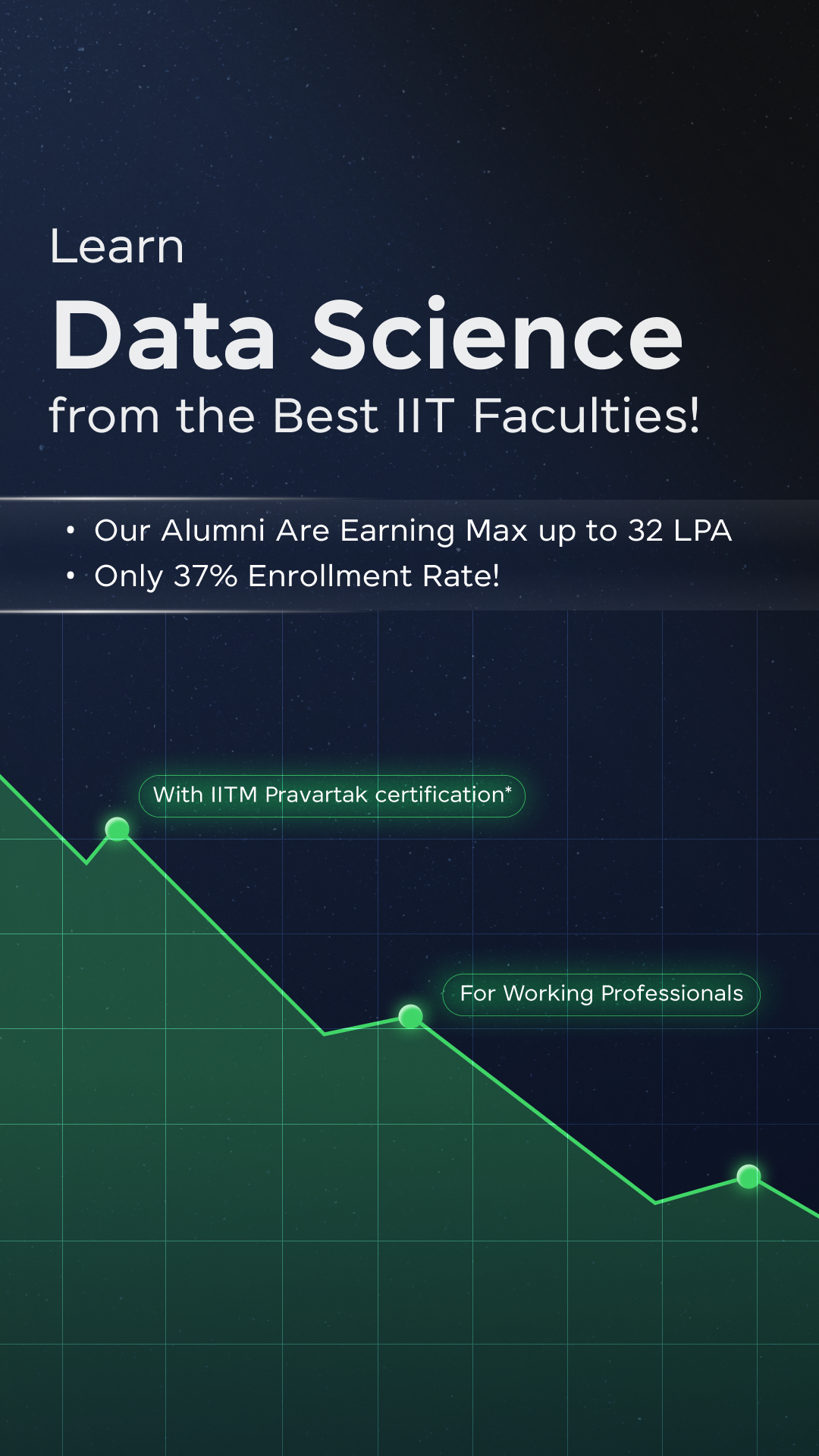














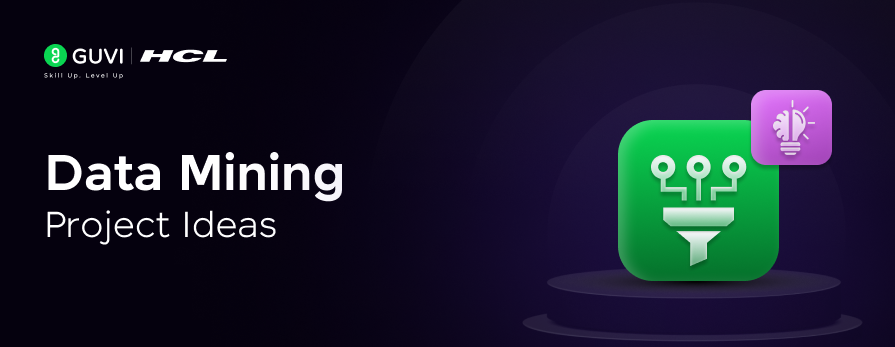
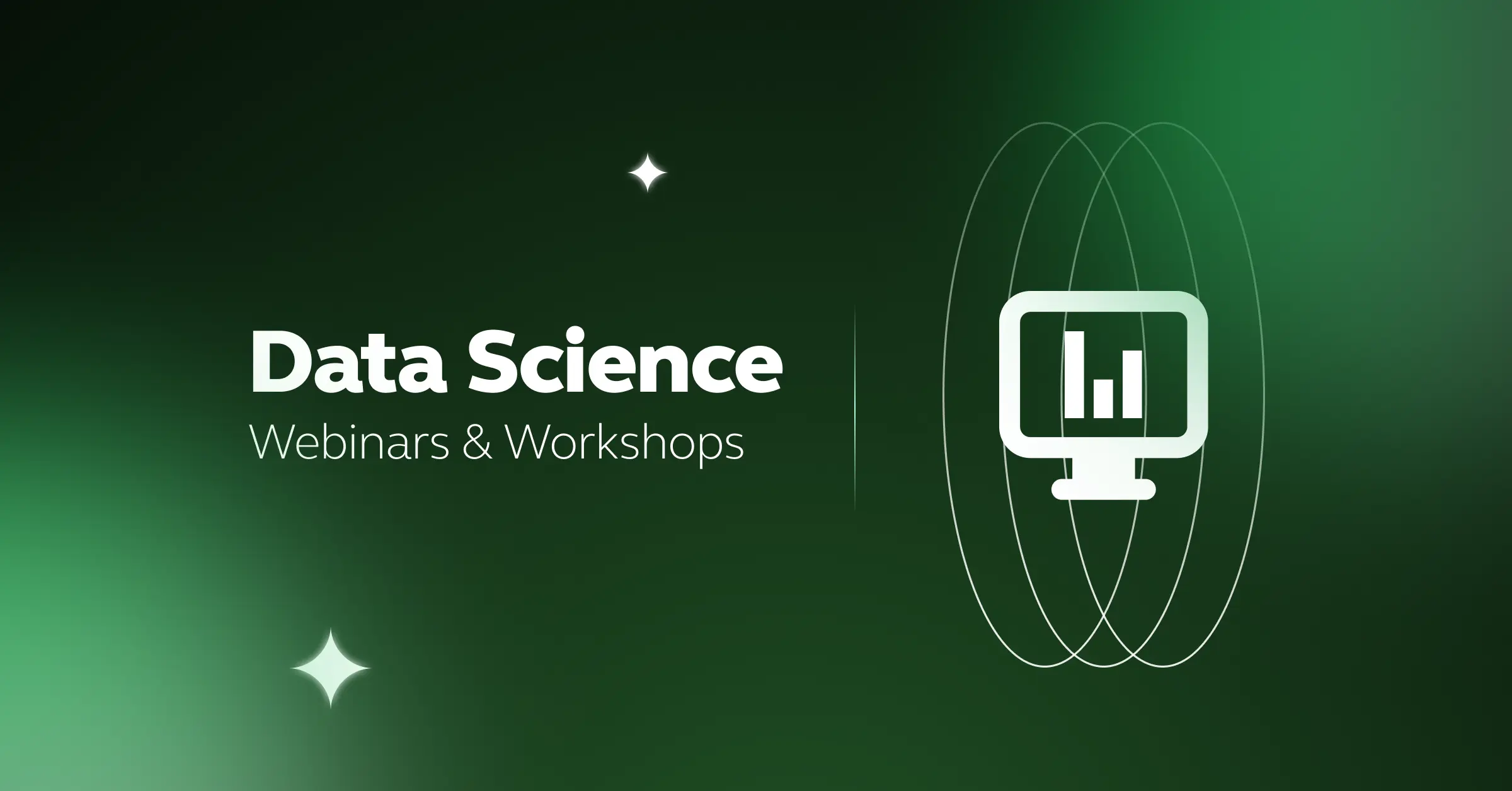
![Top 13 Tableau Projects [with Source Code] 11 tableau projects](https://www.guvi.in/blog/wp-content/uploads/2024/11/Tableau-Project-Ideas.png)

![10 Brilliant Hadoop Project Ideas [With Source Code] 13 Hadoop Project Ideas](https://www.guvi.in/blog/wp-content/uploads/2024/11/Hadoop-Project-Ideas.png)



Did you enjoy this article?